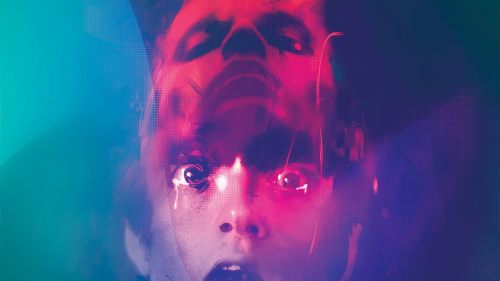SXSW Review: DANIEL ISN’T REAL Is A Sinister Cinematic Treat
It’s speculated that the concept of imaginary friends dates back to the late 1800s when professionals originally tried to study the mysterious phenomenon. Historically, these beings were described as supernatural creatures or spirits thought to connect people with their past lives. Other times, imaginary friends were considered to be guardian angels or muses that functioned as spiritual companions providing comfort, inspiration, and guidance. The psychological and social phenomenon has been studied more thoroughly over the past couple of decades with theories for their existence ranging from the way a child expresses internal conflict, the compensation for something missing in a child’s life, or the need to control their environment. Director Adam Egypt Mortimer (Some Kind of Hate, Holidays) uniquely utilizes an imaginary friend narrative to compound themes of trauma, mental illness, and identity with a diabolically inventive flare in his latest film, Daniel Isn’t Real.
Based on the book In This Way I Was Saved by author and screenwriter Brian DeLeeuw, the film invites audiences into the life and mind of a man named Luke (Miles Robbins, Blockers). At a young age, Luke witnesses a traumatic event of bloodshed which immediately leads to the creation of Daniel, his imaginary best friend. Their interactions mostly consist of innocently imaginative sword fights in make-believe castles with trusty broomsticks as their weapons. Their games quickly came to a halt when Daniel’s perpetual influence almost led to a fatal outcome. With the help of his mother Claire (Mary Stuart Masterson, Fried Green Tomatoes, The Cake Eaters), young Luke banishes Daniel to his grandmother’s antique dollhouse, locked away both physically and metaphorically. Years later, Claire’s mental state begins to collapse. To help cope, Luke’s therapist suggests he embrace a repressed part of his inner self by releasing a now older, sleek and sly Daniel (Patrick Schwarzenegger) back into the world.
Once they’re reunited, the two friends pick up right where they left off. Daniel accompanies Luke to parties to help him get girls, helps him cheat on exams, and play pranks on Luke’s roommate. All of these antics fill a void allowing confidence, charisma, and care-free perceptions of the world to be reinstated. A chance encounter introduces him to the artistic and vibrant Cassie (American Honey’s Sasha Lane). Their exuberant romance is sweetly executed on screen. Luke possesses a compassionate allure that blossoms through his adoration for Cassie’s artistic talent and spontaneity. His patient attraction to her as well as his respectful approach to their consensual encounters asking her “is this ok?” while making advances in bed are all heartwarming moments. However, Daniel grows increasingly impatient and jealous of Luke’s physical autonomy--at first calmly playing coy and then, like a predator waiting for the opportune moment, pounces to devour his prey.
Luke and Daniel are strong character foils, and it’s impressive to see Robbins and Schwarzenegger act with and without acknowledging the other’s presence in a manner that never extracts the audience from their plight. Schwarzenegger’s Daniel possesses a menacing air about him whether he’s quietly sitting in the corner or invasively taunting Luke. Daniel’s demeanor fluctuates from narcissistic playboy to animalistic sociopath as quick as a striking snake. Meanwhile, Robbins’ mental collapse in the wake of trying to care for his mother and be a good partner to Cassie induces a sympathetic response. His moments of weakness can be grounded in relatability for anyone who’s witnessed a parent slowly deteriorate mentally or physically. Each character in the film possesses a dual nature which plays into Mortimer’s intentional theme. Daniel is both charming and cunning; Luke is weak but also strong; Cassie is sympathetic and a spitfire; and, Claire is both dangerously aloof and nurturing. In his director’s statement, Mortimer discusses the use of Daniel’s captivating and nihilistic point of view to thrill audiences with the idea that “people are all one impulsive decision away from violence or true evil.” This thematic dichotomy translates to the other characters through vehicles of mental illness, self-defense, or self-preservation. Drawing on the director’s personal experiences with imaginary friends, loss, and witnessing manic episodes first-hand from loved ones, Mortimer utilizes trauma, self-destruction, and demons to craft the framework of the film visually, but resorts to empathy as the film’s true heart.
The particular method of storytelling in Daniel Isn’t Real is one of deliciously diabolic eye-candy. Mortimer uses color, sound, style, and action to stimulate the feeling of a manic breakdown to really plant the terror of an evil presence residing within. Production designer Kaet McAnneny achieves a haunting, claustrophobic experience by constructing dream-like sets that strategically transmutes into malignant environments depending on the characters’ mental state. The dollhouse is used as a means of entrapment and metaphorically speaks to the manner in which mental illness and trauma can hold one's self hostage. The stunning use of lighting courtesy of cinematographer Lyle Vincent and the practical effects make-up enhance the film’s themes while supplying ample nightmare fuel. In particular, the manner in which Mortimer displays shifts in power is executed with truly impressive use of body horror.
While the film is greatly intoxicating, its mythology regarding Daniel’s origins is obscured by the amalgamation of mental illness, religious references, and supernatural beings. However, this could be the film’s very point, given the historical research on imaginary friends and the vast knowledge we’ve yet to uncover about the psyche (let alone any other worlds that may exist). For all of its fantastic themes and imagery, the script doesn’t pulsate with the same passionate and baleful beat. However, Daniel Isn’t Real tackles mentally and emotionally difficult subject matter with a monstrous amount of talent and employs an empathetic core as its guiding light through the darkness.


